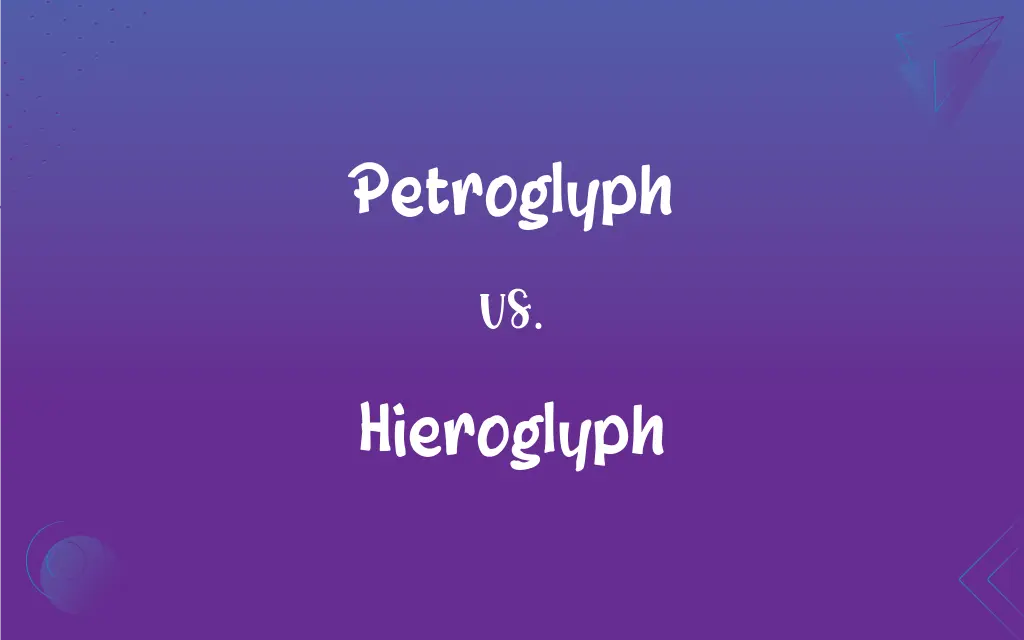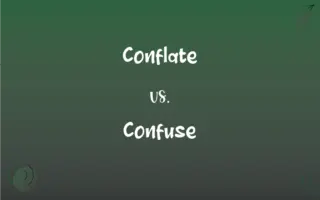Petroglyph vs. Hieroglyph: What's the Difference?
Edited by Aimie Carlson || By Janet White || Updated on October 4, 2023
A "Petroglyph" is an image or design carved into rock surfaces, often by prehistoric peoples, while a "Hieroglyph" is a pictorial character used in the ancient Egyptian writing system.

Key Differences
A Petroglyph primarily refers to images or designs that are carved or inscribed onto rock surfaces. These carvings can be found worldwide and were often created by prehistoric peoples for a variety of reasons, including religious, ceremonial, or as a form of communication. On the other hand, a Hieroglyph is a writing system, specifically, a character or symbol that was used predominantly by the ancient Egyptians.
While Petroglyphs are primarily known for their historical significance and are often found on cave walls or outdoor rock surfaces, Hieroglyphs were not only historical but were also a functional writing system. They can be found on papyrus scrolls, walls of Egyptian temples, tombs, and monuments.
The creation and interpretation of Petroglyphs often remain a mystery, as the exact reasons for their creation or the messages they intended to convey can be speculative. In contrast, Hieroglyphs were extensively studied, especially after the discovery of the Rosetta Stone, leading to a better understanding of their meanings and usage.
Petroglyphs can vary significantly in design from simple geometric shapes to more complex depictions of animals, humans, or symbols. Hieroglyphs, while also varying in design, were more standardized as they were part of a structured writing system.
Broadly speaking, both Petroglyphs and Hieroglyphs give insights into ancient cultures. While Petroglyphs offer a window into the daily life, beliefs, and rituals of prehistoric peoples, Hieroglyphs provide a more direct connection to the language, history, and religious beliefs of ancient Egypt.
ADVERTISEMENT
Comparison Chart
Definition
An image carved into rock
A pictorial character in ancient Egyptian writing
Origins
Global, often by prehistoric peoples
Ancient Egypt
Placement
Rock surfaces, caves
Temples, tombs, papyrus scrolls
Purpose
Varied: religious, ceremonial, communication
Structured writing system
Interpretation
Often speculative
Deciphered, especially after the discovery of the Rosetta Stone
ADVERTISEMENT
Petroglyph and Hieroglyph Definitions
Petroglyph
A rock carving, especially one made by prehistoric people.
The canyon walls were adorned with Petroglyphs that told stories of ancient times.
Hieroglyph
A character used in the ancient Egyptian pictorial writing system.
The walls of the tomb were inscribed with Hieroglyphs telling the story of the pharaoh.
Petroglyph
An engraved or inscribed image on stone.
The Petroglyph showcased intricate patterns and symbols.
Hieroglyph
A picture or symbol representing a word or phrase in ancient Egyptian writing.
He spent years studying the meaning of each Hieroglyph on the ancient papyrus.
Petroglyph
Prehistoric rock art or inscription.
The island was known for its Petroglyphs left behind by its earliest inhabitants.
Hieroglyph
An ancient Egyptian writing character.
Deciphering the Hieroglyphs led to a better understanding of ancient Egyptian culture.
Petroglyph
An image carved on rock by prehistoric people.
The archaeologist discovered a Petroglyph depicting a hunting scene.
Hieroglyph
A pictograph or symbol in the Egyptian writing system.
Each Hieroglyph on the monument had a specific meaning and significance.
Petroglyph
A representation of a figure or design on rock surfaces.
The hikers stumbled upon a Petroglyph that seemed to depict a celestial event.
Hieroglyph
A script predominantly used by the ancient Egyptians.
With the Rosetta Stone's discovery, the mystery of the Hieroglyphs was unlocked.
Petroglyph
A carving or incised drawing on rock, especially one made by prehistoric people.
Hieroglyph
A picture or symbol used in hieroglyphic writing.
Petroglyph
(archaeology) A rock carving, especially one made in prehistoric times.
Hieroglyph
Something that suggests a hieroglyph.
Hieroglyph
An element of an ideographic (hieroglyphic) writing system.
Hieroglyph
(informal) Any obscure or baffling symbol.
Hieroglyph
To represent by hieroglyphs.
Hieroglyph
A sacred character; a character used in picture writing, as of the ancient Egyptians, Mexicans, etc. Specifically, in the plural, the picture writing of the ancient Egyptian priests. It is made up of three, or, as some say, four classes of characters: first, the hieroglyphic proper, or figurative, in which the representation of the object conveys the idea of the object itself; second, the ideographic, consisting of symbols representing ideas, not sounds, as an ostrich feather is a symbol of truth; third, the phonetic, consisting of symbols employed as syllables of a word, or as letters of the alphabet, having a certain sound, as a hawk represented the vowel a.
Hieroglyph
Any character or figure which has, or is supposed to have, a hidden or mysterious significance; hence, any unintelligible or illegible character or mark.
Hieroglyph
Writing that resembles hieroglyphics (usually by being illegible)
Hieroglyph
A writing system using picture symbols; used in ancient Egypt
FAQs
What civilization is most known for using Hieroglyphs?
The ancient Egyptians are most known for using Hieroglyphs.
What tool helped decipher Hieroglyphs?
The Rosetta Stone was crucial in deciphering Hieroglyphs.
Are Petroglyphs considered a form of writing?
While Petroglyphs can convey messages, they aren't a structured writing system like Hieroglyphs.
Can Hieroglyphs be found outside of Egypt?
While primarily Egyptian, Hieroglyphs have been found in areas influenced by ancient Egypt.
Are all Petroglyphs ancient?
While many Petroglyphs are ancient, some cultures continued the practice more recently.
Are Petroglyphs found only in specific regions?
No, Petroglyphs can be found worldwide, from North America to Europe to Asia.
Where can you commonly find Petroglyphs?
Petroglyphs are often found on rock surfaces or in caves worldwide.
Were Hieroglyphs used for everyday writing?
Hieroglyphs were mainly used for religious texts, official inscriptions, and monumental art.
Why did the use of Hieroglyphs decline?
The use of Hieroglyphs declined due to the rise of other writing systems and scripts.
Are Petroglyphs protected in many countries?
Yes, many Petroglyphs sites are protected as they hold historical and cultural significance.
Can anyone decipher Petroglyphs?
While anyone can interpret Petroglyphs, their exact meanings can often be speculative or based on cultural context.
What do Hieroglyphs look like?
Hieroglyphs are pictorial symbols, ranging from animals to objects and abstract shapes.
Can Hieroglyphs be colorful?
Yes, many Hieroglyphs were originally painted, though the colors may have faded over time.
Do Petroglyphs only depict animals?
No, Petroglyphs can depict a variety of images, including humans, symbols, and events.
What materials were used to write Hieroglyphs?
Hieroglyphs were inscribed on stone, wood, and written on papyrus using ink.
How are Petroglyphs created?
Petroglyphs are made by carving or engraving images onto rock surfaces.
Can you read Petroglyphs like a book?
Petroglyphs are more symbolic, and their exact meanings can be speculative.
Was there a cursive form of Hieroglyphs?
Yes, it's called hieratic, and it was a more informal, cursive version of Hieroglyphs.
Are Hieroglyphs found only on monuments?
No, Hieroglyphs can also be found on papyrus scrolls, jewelry, pottery, and more.
Do any cultures still create Petroglyphs today?
While most Petroglyphs are ancient, some modern indigenous groups might still practice rock art.
About Author
Written by
Janet WhiteJanet White has been an esteemed writer and blogger for Difference Wiki. Holding a Master's degree in Science and Medical Journalism from the prestigious Boston University, she has consistently demonstrated her expertise and passion for her field. When she's not immersed in her work, Janet relishes her time exercising, delving into a good book, and cherishing moments with friends and family.
Edited by
Aimie CarlsonAimie Carlson, holding a master's degree in English literature, is a fervent English language enthusiast. She lends her writing talents to Difference Wiki, a prominent website that specializes in comparisons, offering readers insightful analyses that both captivate and inform.































































